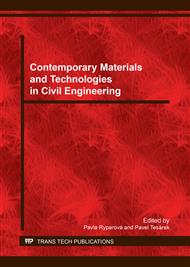p.1
p.10
p.15
p.23
p.29
p.37
p.43
p.49
The Dependence of Concentration Copper Ions in Nanofibers (PVA) on Composition of Original Basic Electrospin Solution and on Kind of Stabilization
Abstract:
The nanofiber textile was made by electrospinning on device Nanospider LB 500 (Elmarco, CR). The original basic polymer solution contains polyvinyl alcohol and additional supplement: a glyoxal and phosphoric acid for thermal stabilization and copper sulphate as a biotic agent. The concentration of copper sulphate pentahydrate (CuSO4·5H2O) in original basic polymer solution was 0.5 and 1% and it follows that the theoretical concentration of copper ions in nanofibers was 0.95 and 1.89%. Subsequently the nanofibers had stabilized by thermal heat (140 °C, 10 min), and by chemical cross linking methods with using of soaking in solution with glutaraldehyde, methanol. The stabilized nanofibers were characterized by scanning electron microscope (SEM) and atomic absorption spectrum (AAS). The results showed that the thermal stabilization did not change nanostructures too much, but subsequent soaking showed, that their structure has changed after 24 hour leaching, the crosslinked points has not sharp line. This measurement leads to conclusion, that the stabilization by heat is not fully absolute. Chemical stabilization nanofibers by glutaraldehyde changed the nanoproperties only in range a few percent and the solubility in water was absolutely completed. The stabilization by methanol has destroyed nanostructures of the fabrics, and the nanofiber textile looks like thin layer or thick membrane. The nanostructures didn't change their character nor after water soaking. The content of copper in nanofiber had measured by (AAS) and thus proved that the copper concentration in nanofiber is independent on original concentration in solution. The next results from this measurement confirm the assumption that the concentrations of copper are dependent on kind stabilization. The next results from this measurement confirm the assumption that the concentrations of copper are dependent on kind stabilization. The stabilization by soaking in stabilization solution leads to decrease of concentration of copper in nanofiber. The thermal stabilization didn't change final content of copper in nanofiber, the stabilization by glutaraldehyde changed the concentration, it was lower by 2 mg/g and the stabilization by methanol made nanofiber with one quarter original value of copper.
Info:
Periodical:
Pages:
23-28
Citation:
Online since:
March 2017
Authors:
Keywords:
Price:
Сopyright:
© 2017 Trans Tech Publications Ltd. All Rights Reserved
Share:
Citation:


